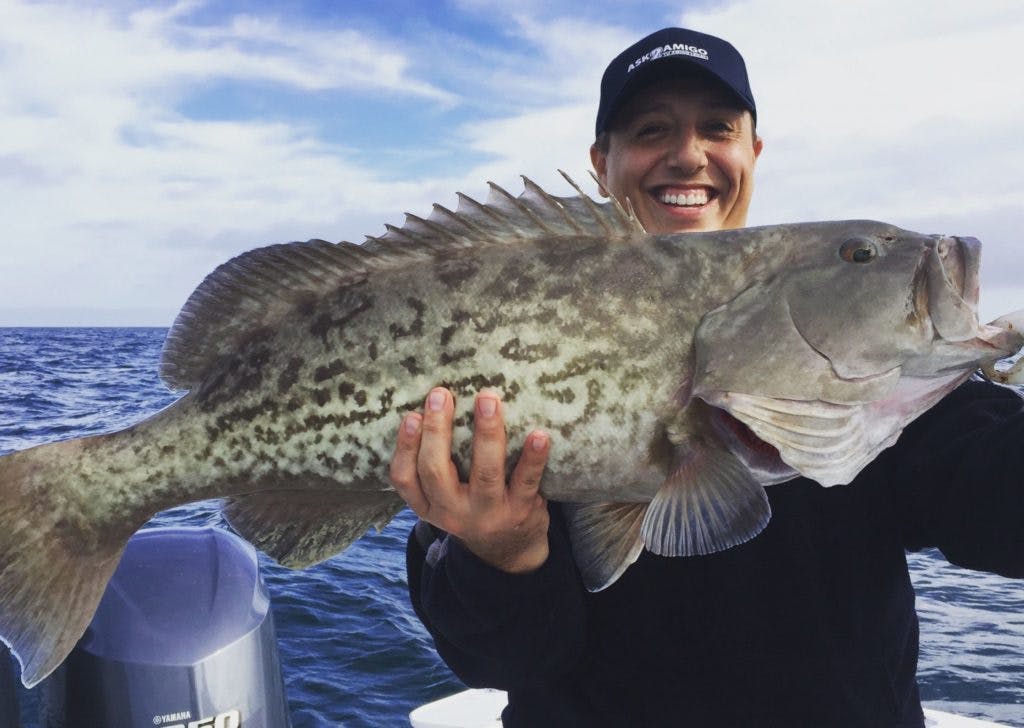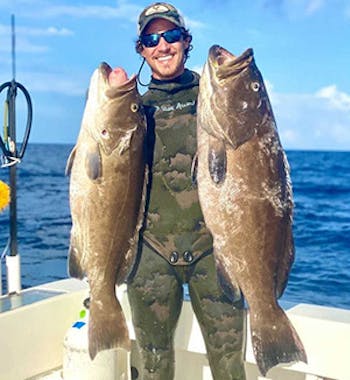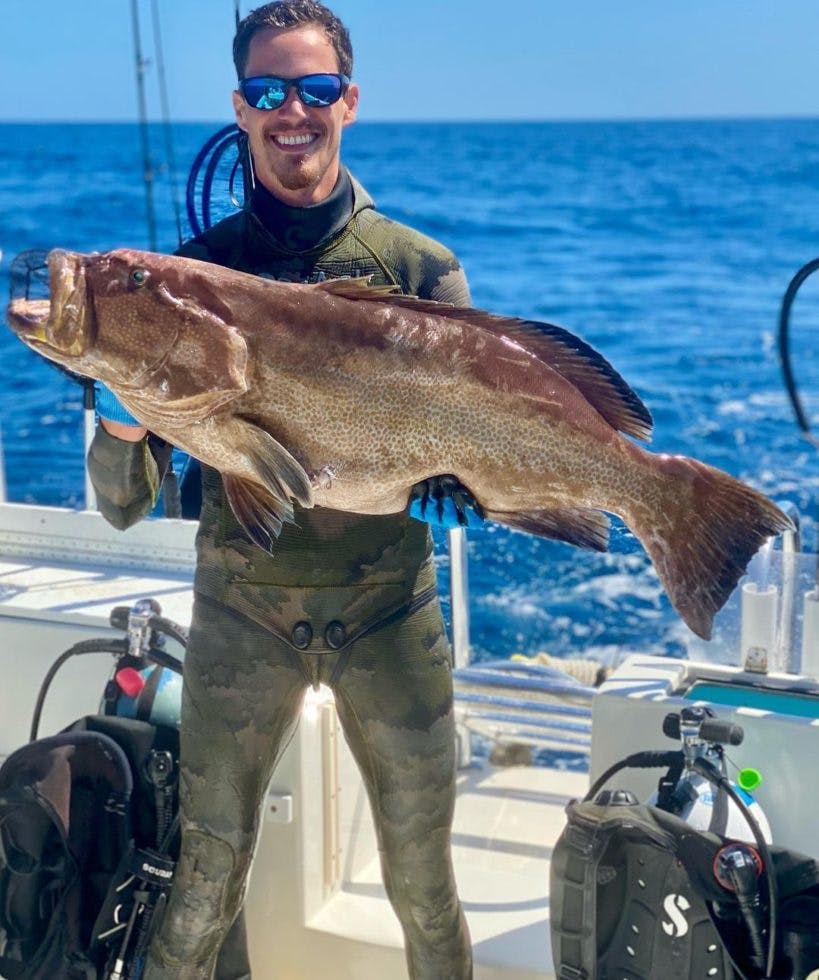Free Shipping on orders of $49+ | Signup for Direct Rewards
Free Shipping on orders of $49+ | Free Store Pickup | Signup for Direct Rewards
Free Shipping on orders of $49+ | Signup for Direct Rewards
Free Shipping on orders of $49+ | Free Store Pickup | Signup for Direct Rewards

With Grouper season upon us, we're here to help ensure you’re all set to catch your daily limit. We’ve got the tips and tricks to make your grouper spearing adventures safer, more efficient, more fruitful, and way more delicious. Learn about grouper types, what gear you’ll need, how to get a better shot, and tips on cleaning and cooking your catch. Shall we dive in?
For the most updated rules and regulations on grouper in Florida, please go to https://myfwc.com/fishing/saltwater/recreational/groupers/
Did you know that there are 159 species of grouper? The most common species in Florida you’ll possibly be hunting are black grouper, gag grouper, red grouper, scamp grouper, yellowfin grouper, and yellowmouth grouper. Some species with more protections around hunting include the nassau grouper and the goliath grouper. Remember, check out the current restrictions and ensure proper identification around your grouper of interest via the Florida Fish and Wildlife Conservation Commission Website before jumping in the water. Once you’re all caught up on the rules and regulations, you can find these amazing fish near wrecks, reefs, and rocky areas. When diving around reefs, always be mindful of your gear and your actions to protect the reef from damage while on the hunt.

Groupers tend to have some pretty tough skin, so while polespears are okay for smaller groupers, you’ll want a fairly powerful speargun for the larger species. Your speargun will be partly dependent on your personal preferences and body structure, then you'll want to consider your prey as well. Since you’ll be potentially weaving through rocky areas, perhaps a shorter speargun is more appropriate for grouper hunting.
Additionally, the type of spear and line you use will be important to consider. A large fish will need to be speared with a large shaft, so one that’s at least 5/16” in thickness will be ideal. Having a double flopper at the end of that shaft is useful as well so your catch of the day doesn’t get away. Here’s a speartip we think would be useful for your hunt: JBL Rock Point Breakaway Speargun Tip.
And since you’ll be working around rocks and reefs with your prey, getting a strong dyneema line like the JBL Dyneema Shooting Line will be best to ensure your line doesn’t get cut by the rocks.
So you’ve got your gear, you’re in the water…. Now what?

You’re exploring the reefs or wrecks on the hunt for your dinner, and when you find it, it may seem like an easy enough idea to just point and shoot at first sight. It's not quite that easy, so here are a few tips to make your hunting more bountiful.
1. Stay calm. Seems obvious, but when you’re new at spearing, you can get excited and feel rushed to get things going. Sudden or erratic movements scare the fish, so excitedly prepping your speargun with quick movements isn’t a great idea. Stay cool, calm, and collected while you’re swimming and as you prep your gear.
2. When stalking your prey, it's a good idea to approach from an angle where they won’t perceive you as a threat. You can descend from above the fish where they can’t see you for a stealthier approach. How close you’ll need to be to the grouper so that you can get the perfect shot depends on visibility, your gear, and your experience level.
3. When aiming anything, including a speargun, don’t rush but don’t hesitate either. Take your time, keep a steady hand, and look exactly at the point you want your spear to land.
4. Always, always, always have a buddy or buddies with you while you hunt. The best hunting days have nothing to do with whether or not you catch anything and are more about safety. Ensuring you and your friends get back on shore to laugh about the day is the best possible outcome.
1. Use a very sharp knife. Like we said earlier, groupers have incredibly tough skin. The sharper the better.
2. Start by cutting from the pectoral fin down to the pelvic fin.
3. Once you have that cut, follow the pectoral fin along the head towards the dorsal side of the fish with your knife.
4. Now go to the tail and cut parallel to the tail all the way to the backbone.
5. From the cut at the tail, begin slicing from tail to head, pulling away the meat as you go in one large fillet.
6. Now that you have your meat, it’s time to feast.
⭐ Pro tip: If you’re not cooking up everything in one evening, get some vacuum-sealed freezer bags and store your grouper meat to use for later. That frozen grouper will stay good for up to a year, but aim for eating it within 3 to 8 months for the best texture - great for the off season.
Good news: Unless you burn your grouper or undercook it, there’s almost no way you can mess up when it comes to cooking your fish. Most fish are actually quite easy to work with, grouper especially. Some seafood seasoning and a splash of lemon or lime is a foolproof way to season your grouper. You can always blacken it, use Italian seasoning, or just use salt and pepper, and your grouper will still be delicious.
But what about cooking?
Perhaps one of the easiest and most common ways to cook a grouper is in a skillet. So for now, let's go over pan-seared grouper.
• First, always pat your fish dry when preparing it - paper towels work just fine. Regardless of how you cook the fish, you’ll want a dry fillet to work with.
• Add the seasoning of your choice to the fish while you wait for the pan to heat.
• When cooking any fish, you’ll want to make sure your pan is quite hot. It’s a good idea to heat your skillet for at least 3 minutes on medium-high heat, then add olive oil or butter before adding your fish.
• When you add your grouper to the skillet you want to hear it sizzle as the meat touches the pan.
• Now, how long you keep the fish on each side will depend on the thickness of your fillet, about 2-3 minutes on each side is a good general starting point. You can always keep flipping it until it looks right - golden on each side.

• If you’re not too concerned about presentation, a great way to check and see if nearly any fish is done cooking is to dig in lightly with a fork. If the fish starts to easily fall into layers, you have a well-cooked fish that’s ready to eat.
• While a pan-seared grouper is delicious on its own, you’ll likely want to dress it up with something. Thankfully grouper is such a mild fish that it can go with just about anything. You can place it on a salad, cut it up for fish tacos, add it to pasta, or simply serve it with a side of vegetables and some mashed potatoes for a simple and delicious dish.
Bon appetit!
We hope these tips and tricks on getting your fish from spear to plate help to make your grouper hunting adventures easier and your grouper cooking more delicious. Of course, if you're looking for more tips for a successful grouper season, check out our Spearfishing Tips playlist.
Find us on Facebook and Instagram (@diversdirect) and let us know how your grouper season is going. Adventure on.
Don’t forget to stop by to check out the Florida Grouper Rules and get your permit before you head out. There are quite a few species of grouper, so make certain you know the rules for each species.
As with anything, once you learn a few skills and techniques, spearfishing is not difficult, though it is exciting and challenging. You do want to ensure you learn proper spearfishing safety techniques as it can become dangerous.
On the most basic level, you take your loaded speargun underwater, properly identify the species you’re hunting, aim, and shoot. Ensuring, of course, there is no one to get hit by a misfire in the area before you shoot. Collect your catch and head back.
Ask 5 spearos, you’ll likely get 5 different answers. It really depends on the environment, your size, and what you’re comfortable with.
Yes. Grouper season in Florida is determined by the Florida Fish and Wildlife Conservation Commission. Check out the Florida Grouper Rules for the most up to date information.
The Goliath Grouper. Harvesting Goliath Grouper is strictly prohibited without a permit. Reference the Florida Grouper Rules to keep yourself in the clear. Don’t forget to read up on the size limits for each species of grouper.
Yes. Here’s where you get your State Reef Fish Angler Designation. And, you’ll need to sign up for the State Reef Fish Survey. Check the gear rules for the area you intend to hunt. Florida Grouper Rules are different based on where you go.
There are 159 species of grouper.